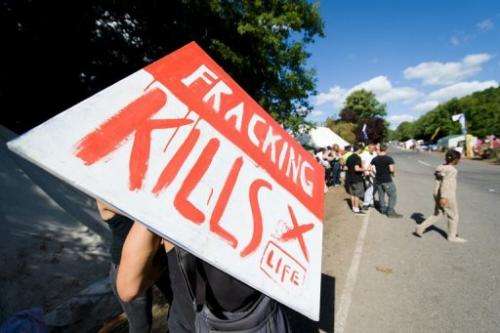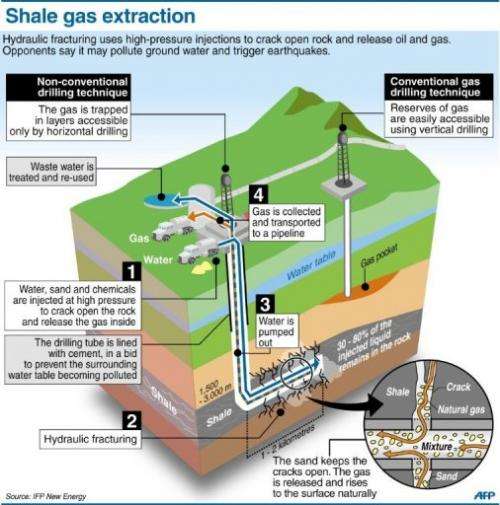Shale pits environmental versus economic interests

Shale oil and gas may be massive untapped energy sources, but the risks of extracting them has drawn calls for tighter regulation or an all-out ban.
To release oil or natural gas locked inside sedimentary shale rock, energy companies inject at high pressure a mixture of water, sand and chemicals deep underground to crack the layer (sometimes called source rock) where the hydrocarbons lurk.
The technology, known as hydraulic fracturing or "fracking," is typically used at depths of 2,000 to 4,000 metres (6,500 to 13,000 feet) below the earth's surface.
The fracking mixture is then partially pumped back up.
Environmentalists have warned gas, mostly methane, or some of the remaining injected mix can eventually rise toward the surface on its own, polluting fresh-water supplies.
But geologists interviewed by AFP downplayed that risk, saying the cracks formed by fracking are generally more than 1,000 metres below the water table, with thick layers of rock in between keeping aquifers safe.
Only one controversial draft study in 2011 by the US Environmental Protection Agency found evidence of ground-water contamination linked to fracking in the town of Pavillion, Wyoming. But EPA officials dropped their probe in June and handed it over to local authorities without drawing final conclusions.
Geologists say the main risk is actually closer to the surface, where the well drilled to inject the fracking mixture underground intersects with the water table.
The well is made of metal tubes encased in cement. If these crack of spring leaks due to the higher pressure then ground-water supplies could be contaminated.
"The risk either comes from the fluids injected into the tube or the fluids coming up out of the tube or even the fluids of the aquifer crossed by the drilling, but it cannot come from something that is by definition very deep like the source rock," said geologist Bruno Goffe at France's National Centre for Scientific Research (CNRS).
Drilling itself is the riskiest aspect, but fracking also brings "additional risk," said Goffe.

"They're using very high pressure in the tubes to crack the rock deep below, and with very very high pressure near the surface, there can obviously be cracks or accidents," he said.
US geologist Susan Brantley recently estimated that between one and three percent of fracking wells have experienced this type of problem. Other studies have found that more than six percent of wells have been affected.
As fracking spreads, so does the risk.
In the United States, more than 10,000 shale wells are drilled each year. And more than a dozen other countries are exploring for shale hydrocarbons or taking steps to do so.
Fracking also takes a big toll on local water supplies.
Every shale-gas well needs between 10 million and 20 million litres (2.64 million and 5.28 million gallons) of water, plus 500 tonnes of sand and 50 tonnes of chemicals, according to Thierry Froment, director general of the oil and gas division at French utilities group Veolia.
About 60 to 80 percent of that mixture eventually comes back to the surface, he said. The rest stays underground.
In the United States, the chemical-laden fracking water is either dumped into separate "waste wells" or treated for re-use in fracking.
The water could be treated for agricultural or other use, but that would cost at least four times as much, according to Veolia.
Opponents condemn use of dangerous chemicals in fracking such as acids, polymers biocides in fracking. Some of these, but not all, can be replaced with biodegradable alternatives.
Some of these chemicals, but not all, can be replaced with biodegradable alternatives.
They also warn fracking can trigger earthquakes.
Geologists say the water injected into "waste wells" can in fact provoke increased seismic activity, but can only trigger significant tremors when an active fault is hit.
Another key concern is leaks of methane, a greenhouse gas 25 times more polluting than carbon dioxide.
Even if just three or four percent of the methane trapped beneath a given well is released, the carbon footprint of shale gas expands to the size of coal's, the most polluting fossil fuel.
A new study from the University of Texas, however, suggests that US fracking operations have sharply reduced methane leaks under tighter regulations.
"There's always a little (that escapes), but it's like plumbing—if you have a good plumber, you have less leaks," said CNRS geologist Goffe.
© 2013 AFP


















